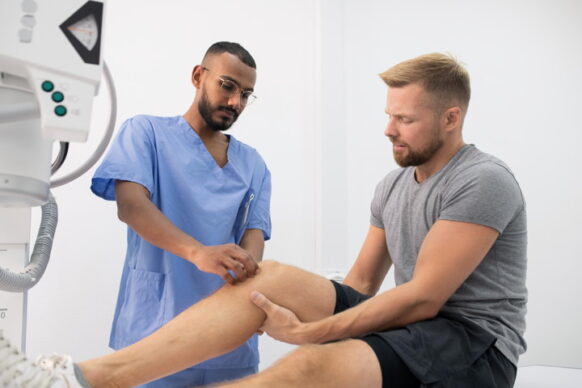Osteoarthritis – Dr. Waldo Floyd
The saddle joint at the thumb base is a common site of OA in the hand.

Osteoarthritis (OA) is the “wear and tear” form of arthritis that we all suffer with age. The saddle joint at the thumb base is a common site of OA in the hand. The condition is known as basal joint OA or OA of the first carpometacarpal joint. The condition is more common in women than in men, but it is present in significant numbers in both genders. Many arthritic joints are not symptomatic, but in many cases, severe pain develops.
In the early stages, symptoms are associated with activities such as turning a key or opening a jar. As the condition worsens, pain may develop at rest and not be associated with symptom provoking tasks. Overtime, the joint may partially dislocate and the thumb may develop deformity and limited motion. Ironically, some patients with minimal deformity will experience significant symptoms and other patients with severe deformity may have little associated pain.
The diagnosis is made by physical examination of the involved joint and x-rays. The condition is frequently in both thumbs, and there may be a familial predisposition.
Treatment is tailored to the patient’s symptoms. Patients having little pain, despite deformity and severe x-ray changes, usually do not require medical intervention. Patients with pain may find long-term relief from a cortisone injection in the joint. Wearing a thumb splint helps pain while the splint is being worn but pain may return with splint removal. Cortisone injections may become ineffective over time.
Some patients will require surgery to manage recalcitrant symptoms. The surgery is usually done as an out-patient procedure with regional anesthesia and often sedation. Surgery for basal joint OA involves removal of the trapezium, the smaller wrist bone at the thumb base. Stability may be maintained with a tendon or synthetic tight rope. Unlike many artificial joint replacements, most basal joint arthroplasties do not wear out over time. In cases where deformity has developed in adjacent joints, surgery may be done also at those sites. The patient’s thumb and wrist are immobilized in a splint or cast for about four weeks. Upon removal of support, occupational therapy with a certified hand therapist to regain motion and strength may be instituted. Most patients experience significant long-term pain relief and an increase in pinch strength.
Many patients with basal joint OA are treated at OrthoGeorgia. Though many of our patients do not require surgery, hundreds annually undergo surgery for this very common and frequently painful condition.

Personalized Orthopaedic Care in Central Georgia
At OrthoGeorgia, we want to help you live a healthier and more comfortable life by giving those in Macon, Warner Robins, Kathleen, Milledgeville, Dublin, Hawkinsville, and the surrounding areas convenient access to the highest quality care. Whether you have been suffering from a sports injury or a common orthopaedic condition, we will determine the cause of your discomfort and craft a personalized treatment plan to bring you relief. To learn more about our services and our physicians, or to schedule an appointment at OrthoGeorgia, please contact us today.







